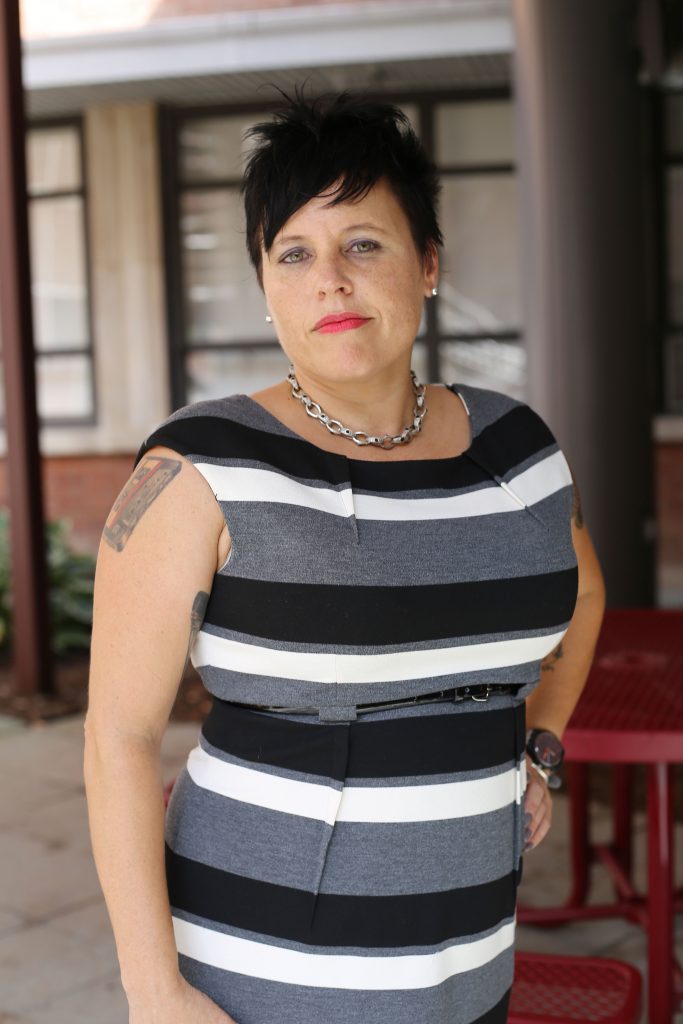
With short, jet-black hair and large gold hoop earrings, professor Jennifer Stoever sits poised and alert in a swivel chair in her deep burgundy office, which is nestled in the bowels of Glenn G. Bartle Library. Stoever, who is in her ninth year at Binghamton University, has been doing research focused on how racial identity and authority are conveyed through sound.
Stoever teaches both undergraduate and graduate-level English courses and runs an academic blog. She has recently finished a book and has plans for a guided historical walk through Downtown Binghamton.
And while she is involved in the local area, she originally received her Ph.D. from the University of Southern California, where she wrote her dissertation on how sound conveys the depth of racial subjection.
“When reading literature, I don’t leave sound studies in a different category,” Stoever said. “We miss important ideas in texts when we focus only on the visual.”
Before attending graduate school, Stoever was a high school teacher in the program Advancement Via Individual Determination (AVID), helping underrepresented students become college-bound. While she was teaching, two people she was very close to were killed: a friend at a party and a former student, Tyisha Miller.
“This [student] was someone I had helped with English papers,” Stoever said. “It was life-changing.”
Prompted to take action, Stoever went on to attend graduate school to learn more about how to challenge institutional structures.
Stoever’s first research book, titled “The Sonic Color Line: Race and the Cultural Politics of Listening,” is about the impact of historical racial ideology on listening in the United States from 1845 to 1945. The book begins at the apex of slavery and ends in the time period where the idea of people no longer seeing race is introduced. The book also addresses microaggressions.
Racial profiling in terms of looks is more easily understood, whereas discussions about accent and music evade our understanding. The assumption that sound is malleable places pressure on individuals to figure out how to conform and if they should.
“In Binghamton’s bar, Dillinger’s, there was a sign reading, ‘No bro or yo here.’ We use those sounds to talk about race without mentioning it,” Stoever explained. “Denying that is just not true.”
Stoever has been a victim of policed speech in academia. Once in a mock interview, she was told by a professor she sounded like a Valley girl.
“I grew up close to the [San Fernando] Valley; regionally that sound was everywhere in air,” Stoever said. “Being called out for that stung.”
The stigma of the Long Island accent in Binghamton is similar to that of Valley girl voice in southern California. Conscious of how the “professor voice” can alienate students, Stoever sometimes intentionally plays up the southern California voice in class.
Growing up, she was always around or part of a music scene and missed that in Binghamton. To combat the way interdisciplinary studies are set up here and to keep in touch with two of her best graduate students, she created the blog “Sounding Out!”
The blog has become a staple in the online community that allows Stoever to foster connections with people globally. In a search for regular writers for the blog, Stoever was put in contact with Enongo Lumumba-Kasongo, whose stage name as a rapper is Sammus, a Ph.D. student at Cornell University with a focus on recording studios in a global context.
“When I learned her songs are about about sci-fi, nerdy stuff, social justice, being a woman and [an] artist I fell in love,” Stoever said.
Stoever is also on the board of The Cornell University Hip Hop Collection. A few weeks from now, she will be moderating a panel at a global punk conference in Ithaca with guests Debbie Harry, Chris Stein, Ian MacKaye from Fugazi and Victoria Ruiz from Downtown Boys.
With the help of students, Stoever anticipates the Binghamton Historical Soundwalk Project, a real-life application of her studies. The goal is to have students be able to give guided soundwalks Downtown on First Fridays highlighting how the history and future of the space are connected and bridging the disconnect between students and permanent residents.


